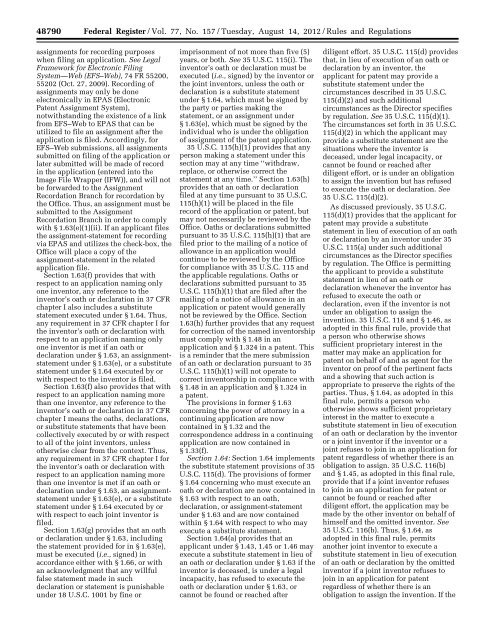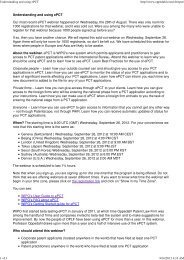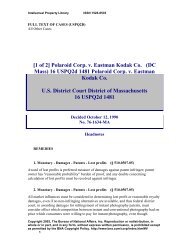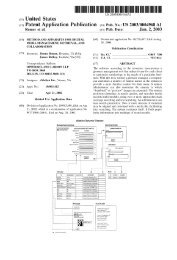sro<strong>be</strong>rts on DSK5SPTVN1PROD with RULES48790 Federal Register / Vol. 77, No. 157 / Tuesday, August 14, 2012 / Rules and Regulationsassignments for recording purposeswhen filing an application. See LegalFramework for Electronic FilingSystem—Web (EFS–Web), 74 FR 55200,55202 (Oct. 27, 2009). Recording ofassignments may only <strong>be</strong> doneelectronically in EPAS (ElectronicPatent Assignment System),notwithstanding the existence of a linkfrom EFS–Web to EPAS that can <strong>be</strong>utilized to file an assignment after theapplication is filed. Accordingly, forEFS–Web submissions, all assignmentssubmitted on filing of the application orlater submitted will <strong>be</strong> made of recordin the application (entered into theImage File Wrapper (IFW)), and will not<strong>be</strong> forwarded to the AssignmentRecordation Branch for recordation bythe Office. Thus, an assignment must <strong>be</strong>submitted to the AssignmentRecordation Branch in order to complywith § 1.63(e)(1)(ii). If an applicant filesthe assignment-statement for recordingvia EPAS and utilizes the check-box, theOffice will place a copy of theassignment-statement in the relatedapplication file.Section 1.63(f) provides that withrespect to an application naming onlyone inventor, any reference to theinventor’s oath or declaration in 37 CFRchapter I also includes a substitutestatement executed under § 1.64. Thus,any requirement in 37 CFR chapter I forthe inventor’s oath or declaration withrespect to an application naming onlyone inventor is met if an oath ordeclaration under § 1.63, an assignmentstatementunder § 1.63(e), or a substitutestatement under § 1.64 executed by orwith respect to the inventor is filed.Section 1.63(f) also provides that withrespect to an application naming morethan one inventor, any reference to theinventor’s oath or declaration in 37 CFRchapter I means the oaths, declarations,or substitute statements that have <strong>be</strong>encollectively executed by or with respectto all of the joint inventors, unlessotherwise clear from the context. Thus,any requirement in 37 CFR chapter I forthe inventor’s oath or declaration withrespect to an application naming morethan one inventor is met if an oath ordeclaration under § 1.63, an assignmentstatementunder § 1.63(e), or a substitutestatement under § 1.64 executed by orwith respect to each joint inventor isfiled.Section 1.63(g) provides that an oathor declaration under § 1.63, includingthe statement provided for in § 1.63(e),must <strong>be</strong> executed (i.e., signed) inaccordance either with § 1.66, or withan acknowledgment that any willfulfalse statement made in suchdeclaration or statement is punishableunder 18 U.S.C. 1001 by fine orimprisonment of not more than five (5)years, or both. See 35 U.S.C. 115(i). Theinventor’s oath or declaration must <strong>be</strong>executed (i.e., signed) by the inventor orthe joint inventors, unless the oath ordeclaration is a substitute statementunder § 1.64, which must <strong>be</strong> signed bythe party or parties making thestatement, or an assignment under§ 1.63(e), which must <strong>be</strong> signed by theindividual who is under the obligationof assignment of the patent application.35 U.S.C. 115(h)(1) provides that anyperson making a statement under thissection may at any time ‘‘withdraw,replace, or otherwise correct thestatement at any time.’’ Section 1.63(h)provides that an oath or declarationfiled at any time pursuant to 35 U.S.C.115(h)(1) will <strong>be</strong> placed in the filerecord of the application or patent, butmay not necessarily <strong>be</strong> reviewed by theOffice. Oaths or declarations submittedpursuant to 35 U.S.C. 115(h)(1) that arefiled prior to the mailing of a notice ofallowance in an application wouldcontinue to <strong>be</strong> reviewed by the Officefor compliance with 35 U.S.C. 115 andthe applicable regulations. Oaths ordeclarations submitted pursuant to 35U.S.C. 115(h)(1) that are filed after themailing of a notice of allowance in anapplication or patent would generallynot <strong>be</strong> reviewed by the Office. Section1.63(h) further provides that any requestfor correction of the named inventorshipmust comply with § 1.48 in anapplication and § 1.324 in a patent. Thisis a reminder that the mere submissionof an oath or declaration pursuant to 35U.S.C. 115(h)(1) will not operate tocorrect inventorship in compliance with§ 1.48 in an application and § 1.324 ina patent.The provisions in former § 1.63concerning the power of attorney in acontinuing application are nowcontained in § 1.32 and thecorrespondence address in a continuingapplication are now contained in§ 1.33(f).Section 1.64: Section 1.64 implementsthe substitute statement provisions of 35U.S.C. 115(d). The provisions of former§ 1.64 concerning who must execute anoath or declaration are now contained in§ 1.63 with respect to an oath,declaration, or assignment-statementunder § 1.63 and are now containedwithin § 1.64 with respect to who mayexecute a substitute statement.Section 1.64(a) provides that anapplicant under § 1.43, 1.45 or 1.46 mayexecute a substitute statement in lieu ofan oath or declaration under § 1.63 if theinventor is deceased, is under a legalincapacity, has refused to execute theoath or declaration under § 1.63, orcannot <strong>be</strong> found or reached afterVerDate Mar2010 17:28 Aug 13, 2012 Jkt 226001 PO 00000 Frm 00016 Fmt 4701 Sfmt 4700 E:\FR\FM\14AUR6.SGM 14AUR6diligent effort. 35 U.S.C. 115(d) providesthat, in lieu of execution of an oath ordeclaration by an inventor, theapplicant for patent may provide asubstitute statement under thecircumstances descri<strong>be</strong>d in 35 U.S.C.115(d)(2) and such additionalcircumstances as the Director specifiesby regulation. See 35 U.S.C. 115(d)(1).The circumstances set forth in 35 U.S.C.115(d)(2) in which the applicant mayprovide a substitute statement are thesituations where the inventor isdeceased, under legal incapacity, orcannot <strong>be</strong> found or reached afterdiligent effort, or is under an obligationto assign the invention but has refusedto execute the oath or declaration. See35 U.S.C. 115(d)(2).As discussed previously, 35 U.S.C.115(d)(1) provides that the applicant forpatent may provide a substitutestatement in lieu of execution of an oathor declaration by an inventor under 35U.S.C. 115(a) under such additionalcircumstances as the Director specifiesby regulation. The Office is permittingthe applicant to provide a substitutestatement in lieu of an oath ordeclaration whenever the inventor hasrefused to execute the oath ordeclaration, even if the inventor is notunder an obligation to assign theinvention. 35 U.S.C. 118 and § 1.46, asadopted in this final rule, provide thata person who otherwise showssufficient proprietary interest in thematter may make an application forpatent on <strong>be</strong>half of and as agent for theinventor on proof of the pertinent factsand a showing that such action isappropriate to preserve the rights of theparties. Thus, § 1.64, as adopted in thisfinal rule, permits a person whootherwise shows sufficient proprietaryinterest in the matter to execute asubstitute statement in lieu of executionof an oath or declaration by the inventoror a joint inventor if the inventor or ajoint refuses to join in an application forpatent regardless of whether there is anobligation to assign. 35 U.S.C. 116(b)and § 1.45, as adopted in this final rule,provide that if a joint inventor refusesto join in an application for patent orcannot <strong>be</strong> found or reached afterdiligent effort, the application may <strong>be</strong>made by the other inventor on <strong>be</strong>half ofhimself and the omitted inventor. See35 U.S.C. 116(b). Thus, § 1.64, asadopted in this final rule, permitsanother joint inventor to execute asubstitute statement in lieu of executionof an oath or declaration by the omittedinventor if a joint inventor refuses tojoin in an application for patentregardless of whether there is anobligation to assign the invention. If the
Federal Register / Vol. 77, No. 157 / Tuesday, August 14, 2012 / Rules and Regulations48791sro<strong>be</strong>rts on DSK5SPTVN1PROD with RULESOffice does not permit the applicant toalso provide a substitute statement inlieu of an oath or declaration wheneverthe inventor or a joint inventor hasrefused to execute the oath ordeclaration (even if the inventor or jointinventor is not under an obligation toassign the invention), a person whootherwise shows sufficient proprietaryinterest in the matter who provides ashowing that such action is appropriateto preserve the rights of the parties, orthe remaining inventor or inventors,may <strong>be</strong> the applicant under either 35U.S.C. 118 or 116(b), respectively, butmay <strong>be</strong> precluded from providing asubstitute statement in lieu of an oath ordeclaration. This is consistent withexisting Office practice under which aperson who otherwise shows sufficientproprietary interest in the matter or theremaining inventor or inventors mayexecute the oath or declaration as theapplicant if all of the inventors haverefused to execute the oath ordeclaration.Section 1.64(b) provides that asubstitute statement under § 1.64 must:(1) comply with the requirements of§ 1.63(a), identifying the inventor orjoint inventor with respect to whom asubstitute statement in lieu of an oath ordeclaration is executed, and statingupon information and <strong>be</strong>lief the factswhich such inventor is required to state;(2) identify the person executing thesubstitute statement and therelationship of such person to theinventor or joint inventor with respectto whom the substitute statement isexecuted, and unless such informationis supplied in an application data sheetin accordance with § 1.76, the residenceand mailing address of the personsigning the substitute statement; and (3)identify the circumstances permittingthe person to execute the substitutestatement in lieu of an oath ordeclaration under § 1.63, namelywhether the inventor is deceased, isunder a legal incapacity, cannot <strong>be</strong>found or reached after a diligent effortwas made, or has refused to execute theoath or declaration under § 1.63. Section1.64(b) also provides that, unless suchinformation is supplied in anapplication data sheet in accordancewith § 1.76, the substitute statementmust also identify: (1) each inventor byhis or her legal name; and (2) the lastknown mailing address where theinventor customarily receives mail, andlast known residence, if an inventorlives at a location which is differentfrom where the inventor customarilyreceives mail, for each inventor who isnot deceased or under a legalincapacity.Section 1.64(c) provides that a personmay not execute a substitute statementunder § 1.64 for an application unlessthat person has reviewed andunderstands the contents of theapplication, including the claims, and isaware of the duty to disclose to theOffice all information known to theperson to <strong>be</strong> material to patentability asdefined in § 1.56.Section 1.64(d) provides that anyreference to an inventor’s oath ordeclaration also includes a substitutestatement provided for in § 1.64.Section 1.64(e) provides that asubstitute statement under § 1.64 mustcontain an acknowledgment that anywillful false statement made in suchstatement is punishable under 18 U.S.C.1001 by fine or imprisonment of notmore than five (5) years, or both.Section 1.64(f) provides that anonsigning inventor or legalrepresentative may subsequently join inthe application by submitting an oath ordeclaration under § 1.63. Section 1.64(f)also provides that the submission of anoath or declaration by a nonsigninginventor or legal representative in anapplication filed under § 1.43, 1.45 or1.46 will not permit the nonsigninginventor or legal representative torevoke or grant a power of attorney.Section 1.66: Section 1.66 is amendedto eliminate the special provisions foroaths taken <strong>be</strong>fore an officer in acountry other than the United States.Section 1.67: Section 1.67 providesfor a supplemental inventor’s oath ordeclaration (which includes oaths,declarations, assignment-statementsunder § 1.63(e), and substitutestatements under § 1.64) under 35U.S.C. 115(h).Section 1.67(a) provides that theapplicant may submit an inventor’s oathor declaration meeting the requirementsof § 1.63, § 1.64, or § 1.162 to correct anydeficiencies or inaccuracies present inan earlier-filed inventor’s oath ordeclaration. See 35 U.S.C. 115(h)(1).Section 1.67(a) also provides thatdeficiencies or inaccuracies due to thefailure to meet the requirements of§ 1.63(b) in an oath or declaration may<strong>be</strong> corrected with an application datasheet in accordance with § 1.76, exceptthat any correction of inventorship must<strong>be</strong> pursuant to § 1.48.Section 1.67(b) provides that asupplemental inventor’s oath ordeclaration under § 1.67 must <strong>be</strong>executed by the person whoseinventor’s oath or declaration is <strong>be</strong>ingwithdrawn, replaced, or otherwisecorrected.Section 1.67(c) provides that theOffice will not require a person who hasexecuted an oath or declaration inVerDate Mar2010 17:28 Aug 13, 2012 Jkt 226001 PO 00000 Frm 00017 Fmt 4701 Sfmt 4700 E:\FR\FM\14AUR6.SGM 14AUR6compliance with 35 U.S.C. 115 and§ 1.63 or § 1.162 for an application toprovide an additional inventor’s oath ordeclaration for the application. See 35U.S.C. 115(h)(2).Section 1.67(d) contains the provisionof former § 1.67(b) that no new mattermay <strong>be</strong> introduced into anonprovisional application after itsfiling date even if an inventor’s oath ordeclaration is filed to correctdeficiencies or inaccuracies present inthe earlier-filed oath or declaration.Section 1.76: Section 1.76(a) isamended to clarify that an applicationdata sheet may <strong>be</strong> submitted in aprovisional application under 35 U.S.C.111(b), a nonprovisional applicationunder 35 U.S.C. 111(a), or a nationalstage application under 35 U.S.C. 371.Section 1.76(a) is also amended torequire that an application data sheetmust <strong>be</strong> submitted to claim priority toor the <strong>be</strong>nefit of a prior-filed applicationunder 35 U.S.C. 119, 120, 121, or 365 forconsistency with the changes to §§ 1.55and 1.78. Including foreign priority anddomestic <strong>be</strong>nefit claims in the Office’sApplication Data Sheet form (PTO/SB/14) can <strong>be</strong>nefit applicants as the datacan <strong>be</strong> loaded directly into the Office’selectronic systems; thus ensuring thedata is accurately captured. The datawill only load directly into the Office’selectronic systems when the PTO/SB/14is submitted as an EFS–Web FillableForm, rather than a scanned portabledocument format (PDF) image submittedelectronically via EFS–Web. Section1.76(a) is also amended to provide thatthe provisions of § 1.76(c)(2) (discussedsubsequently) are an exception to therequirement that an application datasheet must contain all of the sectionheadings listed in § 1.76(b), with anyappropriate data for each sectionheading.Section 1.76(b)(1) is amended topertain to inventor information, ratherthan applicant information. Asdiscussed previously, the Office plans tocontinue to use the inventor’s name forapplication and patent identificationpurposes as inventor names tend toprovide a more distinct identificationthan assignee name. Section 1.76(b)(1)indicates that inventor informationincludes the legal name, residence, andmailing address of the inventor or eachjoint inventor.Section 1.76(b)(3) is amended toeliminate a suggested classification, byclass and subclass, and the TechnologyCenter, from the application informationportion of the application data sheet.This information is no longer utilized bythe Office in view of internal changesrelating to how applications areclassified.
- Page 1:
UNIFORM CERTIFICATE OF ATTENDANCE F
- Page 4 and 5:
SPTO explains the America Invents A
- Page 6 and 7:
PTO/SB/01A (01-09)Approved for use
- Page 8 and 9:
PTO/SB/ (06-12)Approved for use thr
- Page 10 and 11:
PTO/ (06-12)Approved for use throug
- Page 12 and 13:
PTO/(06-1Approved for use through 0
- Page 14 and 15:
What will change about the oath ord
- Page 16 and 17: Action item●●●If you have not
- Page 18 and 19: But 37 CFR § 1.63 says:A person ma
- Page 20 and 21: ●●●Combined assignment anddec
- Page 22 and 23: ●●●●●●Consequences of i
- Page 24 and 25: How to file the ADSs●●If you pr
- Page 26 and 27: Supplemental ADSAny ADS filed after
- Page 28 and 29: Provisionals●●●Rules are a bi
- Page 30 and 31: Are all assignees applicants?●●
- Page 32 and 33: Substitute Statement●●●This f
- Page 34 and 35: ●●●Docket consequences of the
- Page 36 and 37: New Rule-46 practice67●●●Rule
- Page 38 and 39: Consequences of AIA for PCT filers
- Page 40 and 41: If you are entrusted the US nationa
- Page 42 and 43: ●●●Choosing between a “bypa
- Page 44 and 45: ●●●Getting your name and addr
- Page 46 and 47: Exercises relating to September 16,
- Page 48 and 49: Important AIA webinar September 6
- Page 50 and 51: Exercises relating to September 16,
- Page 52 and 53: 48776 Federal Register / Vol. 77, N
- Page 54 and 55: sroberts on DSK5SPTVN1PROD with RUL
- Page 56 and 57: sroberts on DSK5SPTVN1PROD with RUL
- Page 58 and 59: sroberts on DSK5SPTVN1PROD with RUL
- Page 60 and 61: sroberts on DSK5SPTVN1PROD with RUL
- Page 62 and 63: sroberts on DSK5SPTVN1PROD with RUL
- Page 64 and 65: sroberts on DSK5SPTVN1PROD with RUL
- Page 68 and 69: sroberts on DSK5SPTVN1PROD with RUL
- Page 70 and 71: sroberts on DSK5SPTVN1PROD with RUL
- Page 72 and 73: sroberts on DSK5SPTVN1PROD with RUL
- Page 74 and 75: 48798 Federal Register / Vol. 77, N
- Page 76 and 77: 48800 Federal Register / Vol. 77, N
- Page 78 and 79: 48802 Federal Register / Vol. 77, N
- Page 80 and 81: 48804 Federal Register / Vol. 77, N
- Page 82 and 83: 48806 Federal Register / Vol. 77, N
- Page 84 and 85: 48808 Federal Register / Vol. 77, N
- Page 86 and 87: 48810 Federal Register / Vol. 77, N
- Page 88 and 89: 48812 Federal Register / Vol. 77, N
- Page 90 and 91: 48814 Federal Register / Vol. 77, N
- Page 92 and 93: 48816 Federal Register / Vol. 77, N
- Page 94 and 95: sroberts on DSK5SPTVN1PROD with RUL
- Page 96 and 97: sroberts on DSK5SPTVN1PROD with RUL
- Page 98 and 99: 48822 Federal Register / Vol. 77, N
- Page 100 and 101: sroberts on DSK5SPTVN1PROD with RUL
- Page 102: 48826 Federal Register / Vol. 77, N





